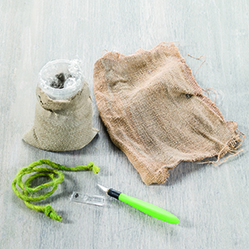Materials:
3400021 Creaflexx Foil, 44.5 x 30 cm / 0.5 mm, Transparent
6832123 MS Multi-Surface – Metallic & Pearl Acrylic, Aquarium
2117154 Wax Glass Beads Luster, 6 mm, Light Turquoise
2163691 Head Pins, 30 x 1.5 x 0.75 mm, Silver Coloured
9735402 Necklace Mechanism, 2 cm
9735291 Choker with Ball Clasp, ø 15 cm / 47 cm, ø 1.1 mm
1791058 Punch M Flower, 23 mm
1793058 Punch L Flower, 35 mm
1794058 Punch XL Flower, 47 mm
1827109 Awl, 9 cm
1802911 Soft-Cut Premium Line Scissors
1803901 Heat Gun
1823004 Modelling and Painting Sponge, ø 7 x 3 cm
9311433 Mixing Palette, 24 x 19 cm
1801810 Gimlet, 2.5 x 3 x 4 x 5 mm
1804003 Hot Glue Gun
1805001 Glue Sticks
1801908 Round Nosed Jewellery Pliers
1801905 Side Cutters
Paper offcut e.g: 1549901 My Colors Cardstock, Snowbound
Additional: Baking Paper, Thin Cotton Gloves, Heat Resistant Pad
1. Cut a flower from scrap paper with each punch. These will serve as templates. Use a needle tool to transfer each flower onto transparent Creaflexx twice and cut out. Use a sponge to cover the Creaflexx flowers with a thin coat of blue pearlescent acrylic paint. Leave to dry.
2. Lay a sheet of baking parchment on top of a heat-resistant mat so that the Creaflexx won’t stick to the mat whilst warm. We also recommend you wear thin cotton gloves whilst working with Creaflexx as it may get very hot during the heating process.
Heat the flowers individually with a heat gun and bend the petals upwards. The smaller the flowers the more the petals should be bent. Transparent Creaflexx cools off very quickly, hardens and retains it’s shape. It can be repeatedly heated and petal positions altered.
3. Use a gimlet to make a hole in the centre of each flower except the largest. Thread a blue bead onto a headpin followed by the flowers (small to large except the largest). Always a place a dab of hot glue in the flower centres to stop them moving. After the last flower, remove the excess headpin with wire cutters and attach the largest flower with a dab of hot glue. Glue the necklace finding to the back of the flower. Temporarily unscrew the ball clasp and straighten the choker wire with jewellery pliers to thread the flower to the desired position. Re-bend the wire and attach the ball clasp.
Advantages: malleable when heated – hardens and retains shape once cool – reformable – can easily be cut with scissors – use any heat resistant surface as a former (e.g. cans, edge of a table, tubes etc.) – can also be embossed when warm.
See the Autumn/Winter Trends Catalogue for white and transparent Creaflexx.
Creaflexx Info:
Available in panels of … (size and thickness)
It is a thermoplastic resin. It can be shaped by heating – it solidifies again as soon as it is cold and then retains the form into which it was shaped. This process can be repeated. You can always reheat Creaflexx and bring it back to form into another shape.
It can also be embossed in the warm state, e.g. with a Spellbinders ™ Platinum ™
– Material can be cut with scissors
– It is recommended to work on a heat-resistant surface and place a layer of baking paper on top of it so that the Creaflexx can not stick to the surface when it is warm.
– Since the material can become very hot, we recommend wearing thin cotton gloves whilst working with Creaflexx.
– If one area is heated for too long, or if the material becomes too hot, the transparent Creaflexx may become milky white.
– The transparent Creaflexx has no adhesive side like the white Creaflexx.
– You always need adhesive to fix it, e.g. UHU Kraft all-purpose adhesive (remains milky after drying) or hot glue gun (clear, but you can still see the glue if the Creaflexx is not painted).
– It has two smooth non-adhesive sides.
In comparison to the white Creaflexx, the transparent Creaflexx must be warmed longer and it also cools and hardens faster.
– Creaflexx can be used, e.g. over table edges, metal cans or pipes. There should always be a layer of baking paper between Creaflexx and the substrate so that the material does not stick. The substate which is to be used as a mold, should be heat-resistant.
– Creaflexx can be decorated with acrylic paint as desired.
– For better durability of the painted surface and a higher resistance to abrasion, it is recommended to finish the piece with a coat of varnish.
– Paints and varnish dry very slowly.
















































